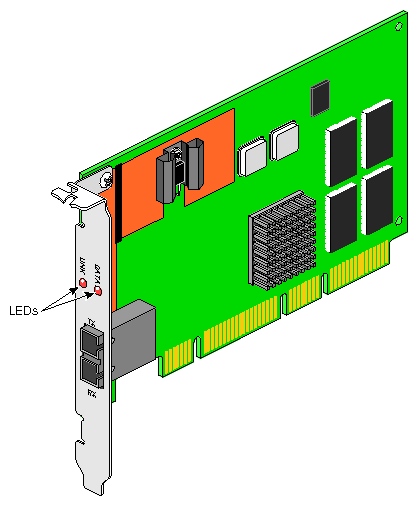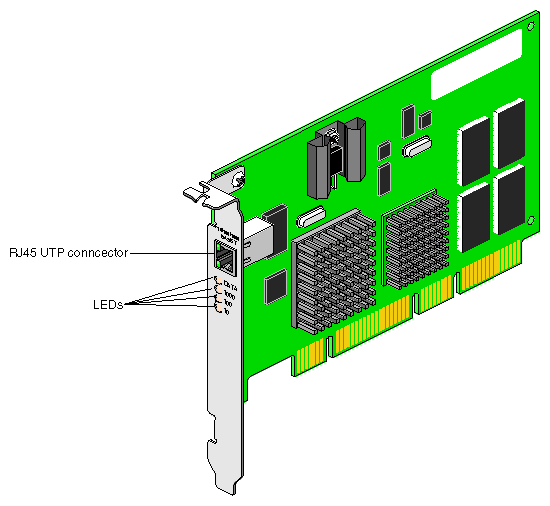Gigabit Ethernet[1] is an extension of existing Ethernet technology that allows computer systems to communicate at speeds up to 1 gigabit per second (Gbps)—theoretically ten times the rate of existing Fast Ethernet (100-Base-T) technology.
Gigabit Ethernet is targeted at backbone networks and interserver connectivity. It provides an upgrade path for high-end workstations that require more bandwidth than Fast Ethernet can provide. It can be installed in an Origin2000, Onyx2, Origin200, or OCTANE system running IRIX version 6.4 or later.
This chapter provides a basic description of the gigabit Ethernet network, and the SGI 1000-BASE-SX Fiber-Optic Gigabit Ethernet board and 10/100/1000-BASE-T Copper Gigabit Ethernet board.
Following is a description of each section:
The Fiber-Optic and Copper Gigabit Ethernet boards are available in two formats, which are adapted for the various Silicon Graphics systems:
Figure 1-1 shows the Fiber-Optic PCI board.
The Fiber-Optic Gigabit Ethernet board includes these features:
full-duplex Gigabit Ethernet interface as defined in the IEEE P802.3z approved standard
standard Ethernet frame size (up to 1518 bytes)
dual DMA channels
adaptive interrupt frequency (maximizes network throughput; adapts to traffic load)
ASIC with on-chip MAC and RISC processors (two)
duplex SC fiber connector
32 MHz, 64-bit and 33 MHz, 66 bit PCI bus master with adaptive DMA
universal dual voltage signaling (3.3 V and 5 V)
compliance with PCI Local Bus Revision 2.1
For full technical specifications of the board, see Appendix A, “Specifications”.
Figure 1-2 shows the PCI Copper board.
The Copper Gigabit Ethernet board includes these features:
full-duplex Gigabit Ethernet interface as defined in the IEEE P802.3ab approved standard
standard Ethernet frame size (up to 1518 bytes)
dual DMA channels
adaptive interrupt frequency (maximizes network throughput; adapts to traffic load)
ASIC with on-chip MAC and RISC processors (two)
32 MHz, 64-bit and 33 MHz, 66 bit PCI bus master with adaptive DMA
compliance with PCI Local Bus Revision 2.1
For full technical specifications of the board, see Appendix A, “Specifications”.
The Gigabit Ethernet board is interoperable with existing Ethernet equipment assuming standard Ethernet minimum and maximum frame size (64 to 1518 bytes), frame format, and compliance with the following standards and protocols:
The Gigabit Ethernet Fiber-Optic board is implemented using fiber-optic cable. The cable, which is not included in the shipment, must be a 50-micron or 62.5-micron multimode duplex cable with an SC connector at each end. Table 1-1 lists SGI fiber-optic cables.
Table 1-1. SGI 62.5-Micron Cable Options for Fiber-Optic Gigabit Ethernet
Length | Marketing Code |
|---|---|
3 m (9.8 feet) | X-F-OPT-3M |
10 m (39.3 feet) | X-F-OPT-10M |
25 m (82 feet) | X-F-OPT-25M |
100 m (328 feet) | X-F-OPT-100M |
Table 1-2 lists operating ranges for 50-micron and 62.5-micron cables for a 1000-BASE-SX port. Fibre type is MM.
Table 1-2. Fiber-Optic Operating Range, 1000-BASE-SX Standard
Diameter (Microns) | Modal Bandwidth (MHz * km) | Range (Meters) |
|---|---|---|
62.5 | 160 | 2 to 220[a] |
62.5 | 200 | 2 to 275[b] |
50 | 400 | 2 to 500 |
5 | 500 | 2 to 550[c] |
[a] The TIA 568 building wiring standard specifies 160/500 MHz * km multimode fiber. [b] The international ISO/IEC 11801 building wiring standard specifies 200/500 MHz * km multimode fiber. [c] The ANSI Fibre Channel specification specifies 500/500 MHz * km 50 micron multimode fiber and 500/500 MHz * km fiber has been proposed for addition to ISO/IEC 11801. | ||
To achieve the longer distances available with 1000-BASE-LX, use a switch with 1000-BASE-LX ports. Figure 1-3 diagrams an example configuration.
The Gigabit Ethernet copper board is implemented using twisted pair cable. The cable, which is not included in the shipment, must be Category-5 cable plant (4-pair) with an RJ45 UTP connector at each end. Table 1-3 lists the SGI twisted pair cables. The operating range for 1000-BASE-T is up to 100 m (328 feet).
To achieve the longer distances available with 1000-BASE-T, use a switch with 1000-BASE-T ports. Figure 1-4 diagrams an example configuration.
Table 1-4 summarizes configuration limits for the Fiber-Optic and Copper Gigabit Ethernet boards.
Table 1-4. Configuration Limits
System | Maximum Number of Boards | Format |
|---|---|---|
OCTANE | One | |
Origin200 (two-CPU system) | One | PCI |
Origin200 (four-CPU system) | One per module/two total | PCI |
Origin200 GIGAchannel | One per module/two total | PCI |
Onyx2 rackmount | Six per module/six total | XIO |
Onyx2 deskside | Three | |
Origin2000 | Six per module/six total | XIO |
[1] Fiber-Optic Gigabit Ethernet is defined in the IEEE standard P802.3z. The Fiber-Optic Gigabit Ethernet board is compatible with this approved standard. Copper Gigabit Ethernet is defined in the IEEE standard P802.3ab. The Copper Gigabit Ethernet board is compatible with this approved standard.



